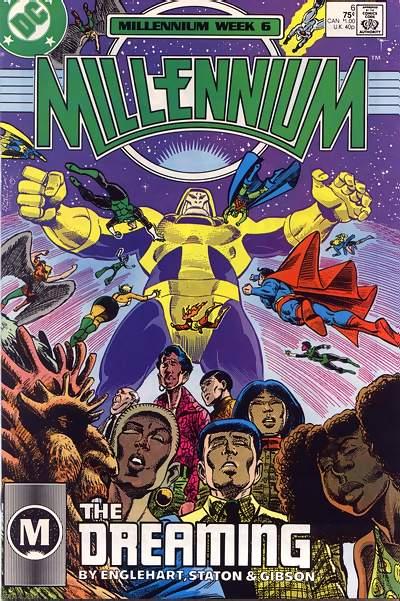It pits a Post-Crisis DCU against the menace of the Manhunters, android servants of the Guardians of the Universe who found them unreliable and scrapped them in favor of the Green Lantern Corps. The Manhunters resented that treatment and used their various powers to infiltrate the universe in an attempt to thwart the goals of their former masters. These Manhunters were first concocted by Jack Kirby in a one-shot effort and later revised by Steve Englehart in his brief but potent run on JLofA.
Englehart is the author of this core story as well and it must've been quite a bit of fun (or perhaps not) trying to tell a story and maintain the momentum of that story when much of the story itself and a great deal of the action happened in other locations and titles.
Reading Millennium is much like it was back in the olden days of comics when distribution wasn't reliable and reading a comic book meant making many assumptions about events not seen in other issues.
My primary attraction to the series is the artwork of Joe Staton. I'm a diehard Staton fan and I followed too little of it at DC. I have almost none of his Green Lantern work, the primary title he focused on while there. I fell in love with Staton on Charlton's E-Man and the crush has never gone away. I followed him to Marvel where he inked a bit and then to DC where he became a force on the stories of the Earth-2 heroes (when there was an Earth-2 that is).
Actually Staton does breakdowns on his series and is finished by Ian Gibson, an artist I have little familiarity with. But I do like the rough and tumble combination of the two here.
The core story of Millennium is that the Guardians and their female counterparts the Zamorans seek to bring into being a new race of immortals. To that end one Guardian and one Zamoran seek out particular Earthers who have the gift which will allow them to elevate to the new status. Along the way some of the candidates are killed or make decisions which make them unsuitable.
One true fact about this series is that Englehart went to great lengths to make sure that this new gang of heroes was not dominated by white men, which was the standard in comics for most of its long history. One of the characters is gay, though this is not explicit. One interesting choice was Tom Kalimaku, the longtime assistant for Green Lantern known by the unfortunate nickname of "Pieface". Another was a villain called the Floronic Man.
Another thing that makes Millennium a difficult read is that so many of the heroes are somewhat revised as a consequence of the Crisis and events since. Much of that varnish has vanished over the intervening decades, but still fresh then were really alternate renditions of Superman, still somewhat of a novice hero despite his iconic standing and a more-than-usual surly Batman. Actual events from the Crisis, such as the compiling of the new Earth's revised history by Harbinger is actually a major plot point for the series as a whole. Harbinger was a fun character in Crisis on Infinite Earths and is interesting here as well. I haven't any inkling what might've become of her since DC has reshaped its universe several times since these heady days.
Holding true to its sub-title the series reveals that many of the people in and around the heroes are actually Manhunters or their agents and this makes the whole of the saga quite unsettled, especially since so many key events happen outside its pages. I can only imagine this is what the Marvel movie universe will be like when Skrulls will continue to pop up here and there and most anywhere.
The upshot of the series, and it takes a long time to get there, is the creation of some new heroes who are sent off into their own title dubbed appropriately The New Guardians. The series didn't last long, so a lot of energy is expended in Milennium for relatively small gain. Alas it is so.
"No man escapes the Manhunters." is the mantra of that duplicitous cult and alas neither does the story in Millennium, at least not completely.
Rip Off













No comments:
Post a Comment